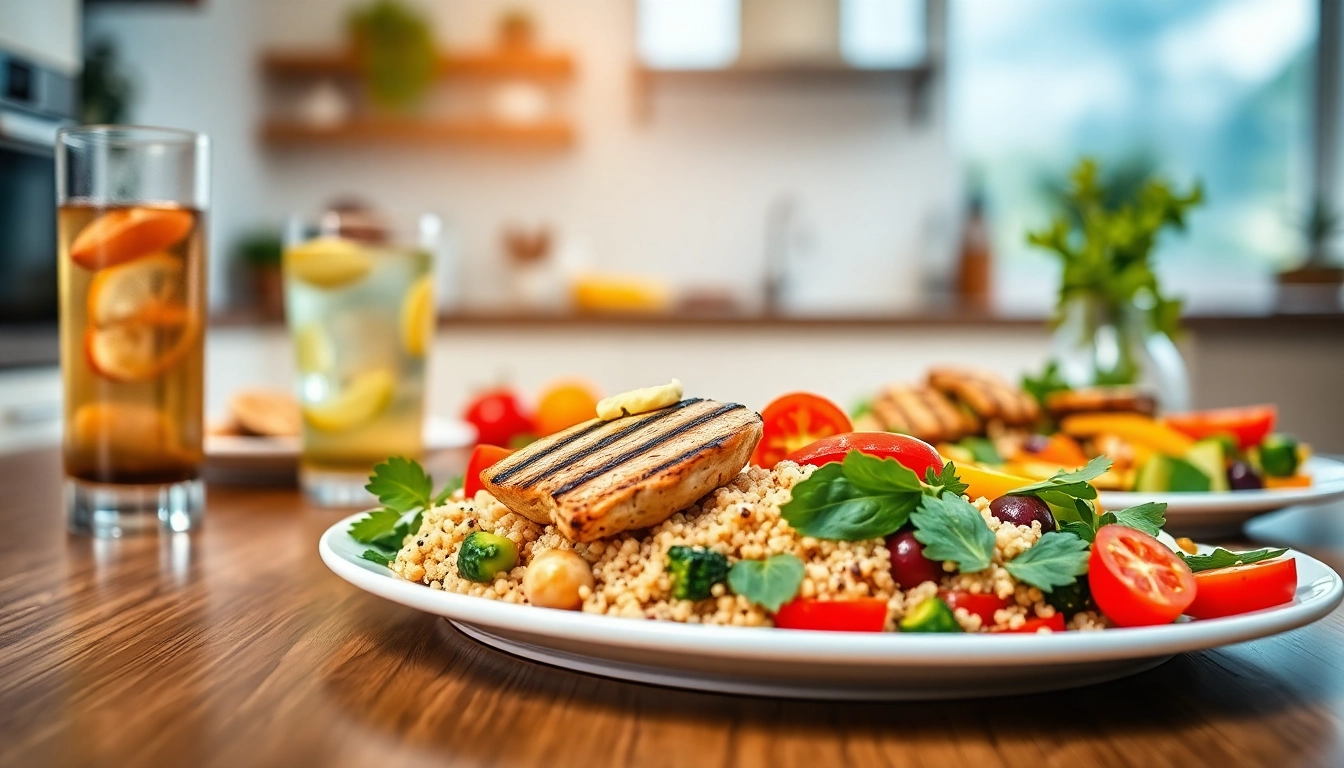Understanding Weight Loss Food Meals
When it comes to shedding pounds, many people immediately turn to drastic diets or exercise regimens. However, the foundation of effective weight loss lies significantly in what we eat. Weight loss food meals play a pivotal role in achieving and maintaining a healthy body weight. They are not just about cutting calories; they focus on nourishing the body and promoting metabolic efficiency.
What Constitutes Weight Loss Food Meals
Weight loss food meals are designed with specific goals in mind. They should be nutrient-dense, balanced, and satisfying, keeping in mind that calorie intake must be tailored to individual needs. Several factors define what makes a meal appropriate for weight loss:
- Nutrient Density: Foods high in vitamins, minerals, and antioxidants while being low in calories—think leafy greens, fruits, whole grains, and lean proteins.
- Portion Control: The quantity of food consumed is just as crucial as the quality. Understanding serving sizes can help prevent overeating.
- Satiety: Incorporating ingredients that enhance feelings of fullness can prevent unhealthy snacking between meals and help control overall calorie consumption.
- Variety: A mix of different food types is essential to ensure a well-rounded intake of nutrients and to keep meals interesting.
Key Nutrients to Include
To create effective weight loss food meals, incorporating a balance of macronutrients and micronutrients is key. Here are the essential components:
- Proteins: Critical for muscle repair and maintenance. Opt for lean sources such as chicken, fish, legumes, and tofu.
- Healthy Fats: Unsaturated fats from sources like nuts, seeds, avocados, and olive oil can aid in satiety and are beneficial for heart health.
- Complex Carbohydrates: Whole grains, fruits, and vegetables are excellent sources of energy and provide fiber, which promotes a healthy digestive system.
- Fiber: Essential for promoting feelings of fullness. Foods rich in fiber include fruits, vegetables, whole grains, and legumes.
- Hydration: Water plays a vital role in metabolic functions and can help control appetite. Staying hydrated can often prevent misinterpretation of thirst as hunger.
Common Myths and Misconceptions
The journey to weight loss is often clouded by misinformation. Debunking common myths can help establish a healthier approach:
- Myth 1: Carbs are bad. Reality: Not all carbs are created equal. Complex carbs are essential for energy.
- Myth 2: Eating fat makes you fat. Reality: Healthy fats are necessary for overall health and can aid in weight control.
- Myth 3: Skipping meals is an effective way to lose weight. Reality: This can lead to overeating later and disrupts the body’s metabolic rate.
- Myth 4: All calories are equal. Reality: The source of calories matters; nutrient-dense foods offer more benefits than empty-calorie options.
Planning Your Weight Loss Food Meals
Once the key concepts of weight loss food meals are understood, the next step is effective planning. A well-structured meal plan ensures that you stay on track while allowing for flexibility and enjoyment in your diet.
Steps to Create a Weekly Meal Plan
Creating a strategic weekly meal plan involves several steps:
- Assess Your Goals: Determine the specific goals regarding your weight loss journey, such as calories needed per day or weight loss targets.
- Choose a Variety of Foods: Select a range of proteins, whole grains, and vegetables to ensure a balanced intake of nutrients.
- Designate Cooking Days: Set aside specific days for meal preparation to save time during the week.
- Create a Grocery List: Based on your planned meals, make a list of all required ingredients, focusing on whole foods.
- Stay Flexible: Allow for spontaneous meals or dining out, but have healthier options in mind to avoid straying off course.
Portion Control Techniques
Mastering portion control is crucial to ensure meal sizes promote weight loss without leaving you feeling deprived. Here are several useful techniques:
- Use Smaller Plates: Serving meals on smaller dishes can help visually control portions.
- Measure Before Serving: Familiarize yourself with standard serving sizes, especially for calorie-dense foods.
- Listen to Your Body: Eating mindfully and recognizing hunger cues can help prevent overeating.
- Build a Balanced Plate: Aim for half the plate to be vegetables, a quarter protein, and a quarter carbs for a balanced meal.
Balancing Macronutrients Effectively
Understanding how to balance macronutrients is essential for creating meals that not only aid weight loss but also support overall health:
The general macronutrient distribution for a weight loss plan could look like this:
- Protein: Approximately 30% of daily caloric intake.
- Fats: Roughly 25% of daily caloric intake.
- Carbohydrates: About 45% of daily caloric intake.
This balance can provide enough energy for daily activities while ensuring adequate protein for muscle maintenance and healthy fats for satiety.
Cooking Techniques for Healthier Meals
Cooking methods can significantly affect the nutritional quality and calorie count of food. Choosing healthier cooking techniques can help maintain the integrity of the food’s nutrients while reducing unnecessary fats and calories.
Best Cooking Methods for Weight Loss Food Meals
Here are some recommended cooking methods:
- Steaming: This technique retains nutrients and prevents the need for excess fats.
- Grilling: Cooking on a grill allows fats to drip off, leading to lower calorie meals.
- Sautéing: Using small amounts of healthy oils can add flavor without significantly increasing calories.
- Baking: Often requires less oil than frying and allows for the creation of a variety of dishes, from proteins to vegetables.
Incorporating Flavor Without Calories
Creating enjoyable meals is vital for long-term adherence to a weight loss plan. Here are some strategies to add flavor without extra calories:
- Herbs and Spices: Fresh herbs and spices can enhance flavor without adding calories.
- Vinegars and Citrus: These can add zest to dishes and provide a burst of flavor without fat.
- Seasonal Produce: Utilizing fruits and vegetables in season not only boosts flavor but is often more affordable.
- Cooking Techniques: Roasting can caramelize natural sugars in food, enhancing flavor without additional fats.
Meal Prepping for Success
Meal prepping is a powerful tool in the fight against unhealthy eating habits. By devoting time to prepare meals in advance, you can avoid last-minute unhealthy choices:
- Cook in Batches: Prepare larger portions of healthy meals and divide them into smaller containers for quick access.
- Use Variety: Make different dishes each week to keep things exciting and prevent food fatigue.
- Label Containers: Clearly mark what each container holds, including preparation dates to track freshness.
Using Weight Loss Food Meals to Stay Motivated
Weight loss is not merely about the food; it also involves mental fortitude and motivation. Aligning meal choices with motivations can keep you on the right track.
Setting Realistic Goals
Objectives should be SMART—Specific, Measurable, Achievable, Relevant, and Time-bound. Consider goals such as:
- Losing a set number of pounds in a month
- Incorporating a certain number of meals each week focused on weight loss
- Improving cooking skills to prepare healthier meals
Tracking Progress Effectively
Monitoring your progress helps maintain accountability. Consider these methods:
- Food Diary: Keep a record of what you eat to identify patterns and areas for improvement.
- Weekly Weigh-Ins: Tracking weight weekly can reveal trends and help adjust as necessary.
- Body Measurements: Taking measurements in addition to weight can show progress even when the scale doesn’t budge.
Building a Support System
Surrounding yourself with a supportive community can enhance your weight loss journey:
- Accountability Partners: Share goals with friends or family members who can help keep you on track.
- Online Communities: Joining forums or social media groups focused on health can provide advice and inspiration.
- Professional Guidance: Consider enlisting the assistance of a nutritionist or dietitian to tailor plans to your needs.
Evaluating and Adjusting Your Meal Plan
As you embark on your weight loss journey, regular evaluation of your meal plan is essential to ensure effective progress. Flexibility can make a significant difference.
Recognizing Signs to Change Your Diet
If you notice stagnation in weight loss or feel continuously fatigued or unsatisfied, it may be time to adjust your approach:
- Plateaus: If weight loss stalls for several weeks despite following your plan, it’s time to re-evaluate your calorie intake or exercise levels.
- Fatigue: Feeling consistently tired may indicate insufficient calorie or nutrient intake; consider modifying food choices.
- Increased Cravings: Persistent cravings can signal the need for more variety or certain nutrients in your diet.
Incorporating Feedback for Improvement
Feedback from your body and progress tracking can guide necessary changes. Collecting insights can involve:
- Personal Reflection: Journaling the experience can illuminate changes needed in food choices or meal timing.
- Professional Input: Seeking feedback from nutrition professionals can leverage their expertise for making informed changes.
Long-Term Maintenance Strategies
Once you’ve achieved your weight loss goals, maintaining those results is equally important. Strategies for long-term success include:
- Continued Meal Planning: Maintain the practice of meal prep to avoid falling back into unhealthy eating habits.
- Educating Yourself: Stay informed about nutrition and wellness to make better choices as lifestyle habits evolve.
- Responsive Adjustments: Be willing to modify goals or dietary approaches as life circumstances change over time.
By focusing on weight loss food meals that are nutritious, satisfying, and enjoyable, you can navigate your weight loss journey with resilience and success. Commitment to the process through strategic meal planning, preparation, and support can yield lasting results and promote a healthier lifestyle overall.



